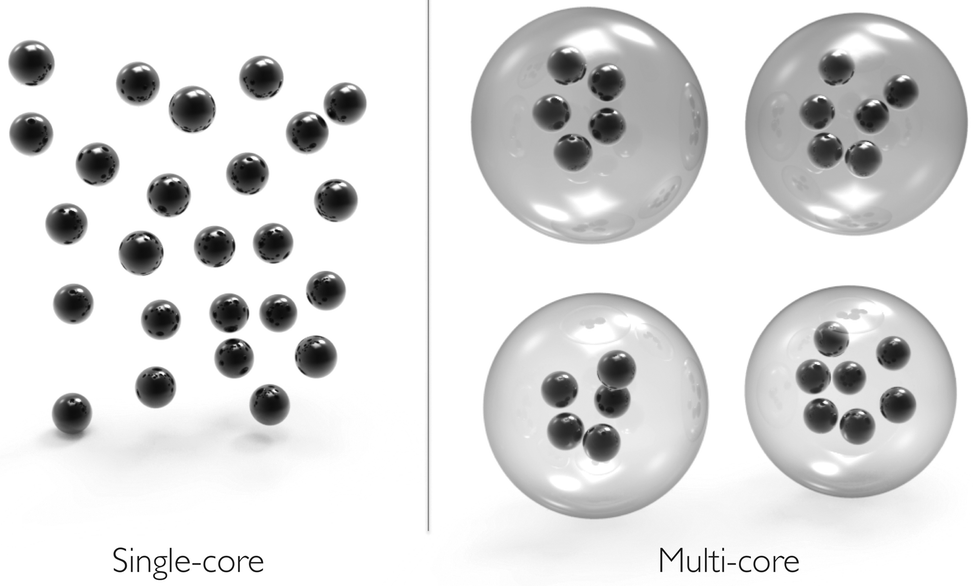Iron-oxide nanoparticles are widely used in isolation techniques, diagnostics, and therapeutic treatments. This large range of applications naturally introduces variability in the way the particles are used and in desired properties and behavior. Luckily, iron-oxide nanoparticles are not all made alike, and one can select nanoparticles based on size, coating, aggregation tendencies, and behavior in magnetic fields. These properties are determined by synthesis methods.
Nanoparticles are classified into two main groups: single-core nanoparticles and multi-core nanoparticles. Single-core particles have one iron-oxide core surrounded by a coating that can vary depending on the intended appication. Multicore particles have more than one iron-oxide particle grouped together in a matrix. It is important to note that both single-core and multi-core nanoparticles are capable of forming aggregates. The amount of aggregation in solution can be controlled by varying the composition of the coating surrounding the iron-oxide core.
The magnetic properties of the particles change with the number of interactions between particles. In solution there are long-range VDW and electrostatic interactions. Additionally, there are short-range dipolar interactions when the nanoparticles come into close contact or form aggregates. These dipolar interactions can significantly change the magnetic properties of the system because multicore, single core, and aggregates of these nanoparticles all behave differently from each other in direct current magnetic fields. The coating or matrix surrounding the particles can have an effect as well. Thus knowing whether to use multicore or single nanoparticles and being able to control the aggregation rate and density of the nanoparticles is important for achieving consistent and desirable results in a particular application. This is especially important in theraputic situations such as drug delivery or tumor ablation by magnetic hyperthermia. The coating in these applications is of particular interest when it must render the nanoparticle safe for in vivo use. When choosing nanoparticles for experimental or therapeutic applications it is good to understand how single and multicore nanoparticles are synthesized.
The following short summary of various synthesis methods is sourced from the paper cited at the end of this article which can be referenced for more detailed information. Briefly, there are two main methods of deriving single-core nanoparticles. The first is aqueous phase synthesis after which the particles are sorted by size and coated with citrate, polyacrylate, or silica to prevent immediate aggregation. Secondly, single-core nanoparticles can be synthesized by organic phase synthesis which is performed either by thermal decomposition of organometallic compounds or the polyol method. These organic methods must have further steps at the end of the protocol to stabilize the particles in aqueous medium or there will be irreversible aggregation.
Multi-core nanoparticles are more common than single-core, but are made from similar aqueous and organic methods. The difference in the aqueous synthesis lies in the coating. Multi-core nanoparticles can have polysaccharide coatings, molecular coatings to maintain colloidal stability via electrostatic repulsion or hydrophilic polymer coatings. Although most multi-core conglomerates form during the initial nucleation and growth phase, an alternative method involves encapsulating pre-made single-core nanoparticles into a liposome. When synthesizing multi-core nanoparticles by organic methods one can use thermal decomposition of organometallic compounds, the polyol method, or gas phase synthesis using laser pyrolysis. Laser pyrolysis methods are capable of forming multi-core nanoparticles less than 50 nm in size.
Synthesis methods to prepare single- and multi-core iron oxide nanoparticles for biomedical applications. Gutiérrez L, et al. Dalton Trans. 2015 Feb 21;44(7):2943-52. doi: 10.1039/c4dt03013c
Related news:
- Magnetically Controlled Movement of Human Adipose-Derived Stem Cells
- The 20th Annual International Conference on Magnetism
- Tumor Depletion with Combined Magnetic Hyperthermia and Photodynamic Therapy





